Spitalfields
This page represents some of the examples of old
lettering found by striking eastwards from Liverpool Street Station,
London. This area is adjacent to that covered in our Shoreditch page.
Spitalfields takes its name from the hospital and priory, St. Mary's
Spittel that was founded in 1197. Lying in the heart of the East End,
it is an area known for its spirit and strong sense of community. It
was in a field next to the priory where the now famous market first
started in the thirteenth century. Historically it has played host to a
transient community, primarily for new immigrants. Spitalfields had
been relatively rural, until the Great Fire of London. By 1666, traders
had begun operating beyond the city gates - on the site where today's
market stands. The landmark Truman's Brewery opened in 1669. In 1682
after the Great Fire of London destroyed much of the city King Charles
II granted John Balch a Royal Charter that gave him the right to hold a
market on Thursdays and Saturdays in or near Spital Square. From 1880
to 1970s Spitalfields was overwhelmingly Jewish; it was probably the
largest Jewish area in Europe receiving refugees from all over Europe,
the Balkans and Russia, with over forty synagogues. As the area grew in popularity, Spitalfields became a
parish in its own right in 1729 when Hawkesmoor's Christ Church was
consecrated. Spitalfields fell into decline after the 1820s and gained
a reputation as cheap area in which to live, proving a magnet to
numerous waves of immigrants. During the 1840s the potato famine led
to an influx of men from Ireland, bringing in workers to build the
nearby docks. By the middle of the 20th century
the Jewish community had mostly moved on. Since the 1970s a thriving
Bangladeshi community has flourished. Today, the area boasts evidence
of a Huguenot church, a Methodist chapel, a Jewish synagogue, and
Muslim mosque. Its cultural traditions are steeped in silk weaving,
leather ware, clock making, cigar making, barrow boys and a thriving
fruit and vegetable market. Poor housing conditions, sweat shops, East
End music hall and the legacy of Jack the Ripper, plus the immense
variety of colours from the ever-vibrant Bangla Town all contribute to
the rich tapestry that is Spitalfields today. It's ironic that
historically one of the poorest, most overcrowded, disease-ridden parts
of London now provides upmarket housing for the wealthier in society,
many in refurbished 'period' lofts and houses.
Commercial
Street
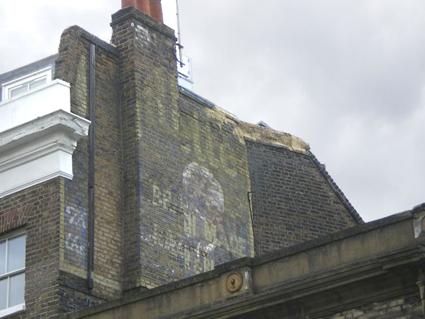
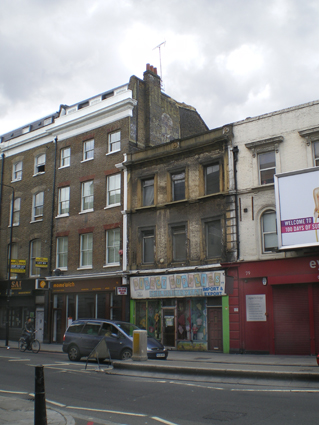 Most images
2011
Most images
2011
Gillette
BRITISH MADE
RAZOR & BLADES
The...
the...
The above painted wall advertisement for Gillette
products is on a wall high above No. 75 Commercial Street, E1; it shows
the vestiges of an
earlier version ('The... the...'). We can do no better than to quote
Sebastien Ardouin's blog (see Links), where he goes into some detail on
this and similar ads:
"I suspect the sign above on Commercial [Street] would originally have
looked like the previous one but Gillette had it repainted at a later
date using its more modern design. A couple of words (twice "The") and
traces of letters from the earlier version can still be spotted in the
lower left-hand corner. A few more letters belonging possibly to a
third, intermediate, Gillette sign can also be seen here and there
("...ety" and "...or", making "Safety Razor")...
[The vestigial picture is probably the likeness of] King Camp Gillette,
the head of the namesake company, whose portrait appeared on the packs
of disposable razor blades."
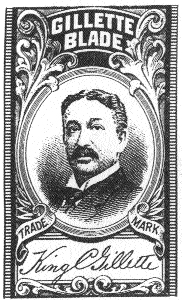
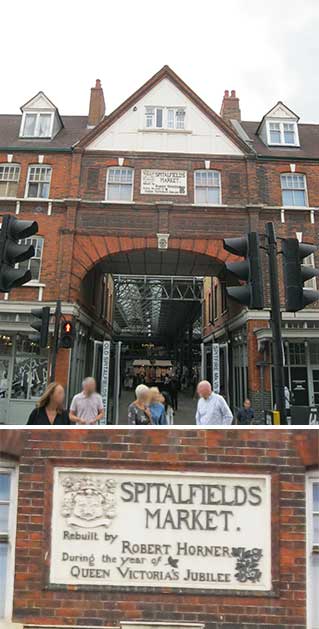 2017 images
2017 images
101-107 Commercial Street includes the arched entrance to:
'SPITALFIELDS
MARKET.
Rebuilt by
ROBERT HORNER
During the year of
QUEEN VICTORIA'S JUBILEE'
There has been a market on the site since 1638 when
King Charles gave a licence for flesh, fowl and roots to be sold on
Spittle Fields, which was then a rural area on the eastern outskirts of
London. The existing buildings were built in the year of Queen
Victoria's Golden Jubilee, 1887, to service a wholesale market, owned
by the City of London Corporation.
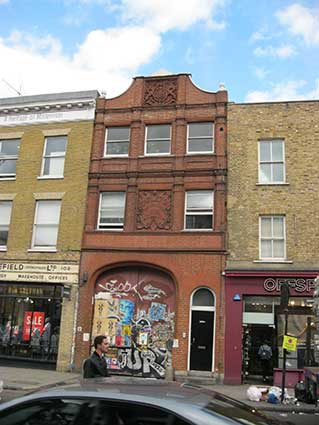
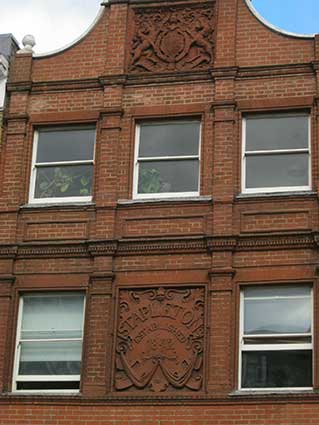
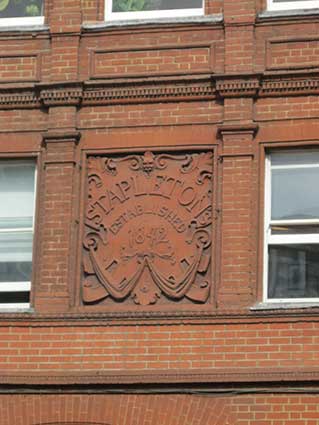
106 Commercial Street features a royal coat of arms and 'Stapleton's,
Established 1842', both in terra cotta panels. Stapleton's, in
the mid 19th century, was a repository where horses were bought and
sold.
91 Brick Lane
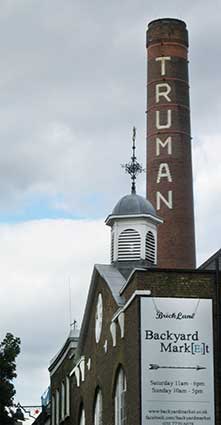
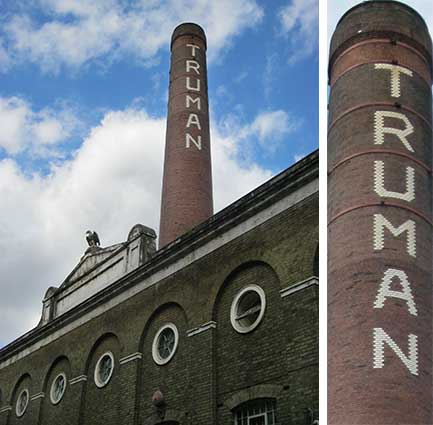 2017 images
2017 images
The Black Eagle Brewery is the former brewing plant of Truman's Brewery
located around Brick Lane, although the official (office) address is 91
Brick Lane. The eponymous eagle can be see atop the pediment fronting
Brick Lane (above centre). Built by Thomas Bucknall around the time of
the Great Fire of London (1666), it was acquired by Joseph Truman in
1679. By 1748 the Black Eagle Brewery was the third largest brewery in
London, and probably the world, with 40,000 barrels produced annually.
In the 21st century, the most striking feature of this campus of
beer-brewing (now, of course, 'The Old Truman Brewery': a ten acre
arts, media and leisure/eating centre) is the factory chimney
featuring bold white brick lettering with iron banding on the red
bricks: a huge advertising sign.

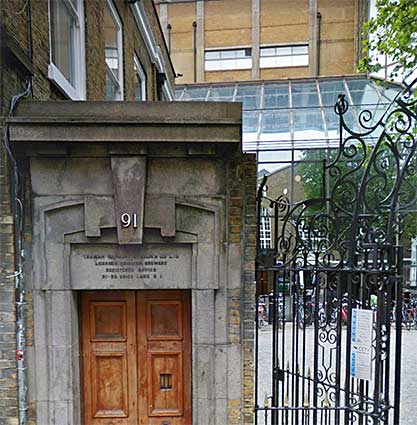
Just down the road and on the other side are the offices of the
brewery. The stone entrance at no. 91 features the relief metal
lettering:
'TRUMAN HANBURY &
BUXTON CO LTD
LICENSED COMMON BREWERS
REGISTERED OFFICE
91-95 BRICK LANE E1'
The shaped board nearby has been thoughtfully
obliterated with maroon paint, which is now degrading in the weather.
With gold characters on a maroon background, the sign reads:
‘TRUMAN
HANBURY & BUXTON
—-
The Truman Brewery was
founded on this site in 1666, the
year of the Great Fire of London,
and has continued ever since to
brew here the beers and ales that
have refreshed Londoners for over
Three Centuries’
The nearby Dray Walk, Buxton Street and Hanbury Street
also commemorate the old brewery and its importance in the area.
46 Crispin
Street
Donovan Brothers, 46 Crispin Street, E1: a plethora of
cartouches of out-of-date text. Scroll down for the story of the
company.
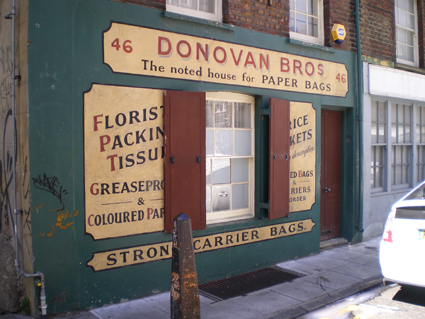 2011 images
2011 images
'46... DONOVAN BROS ...46
The noted house for PAPER BAGS
FLORIST
PACKING
TISSUE
GREASEPROOF
-&-
COLOURED PAPER
PRICE
TICKETS
of every description
PRINTED BAGS
-&-
CARRIERS
TO ORDER
STRONG CARRIER BAGS'
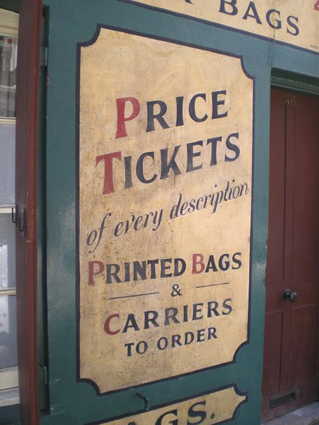
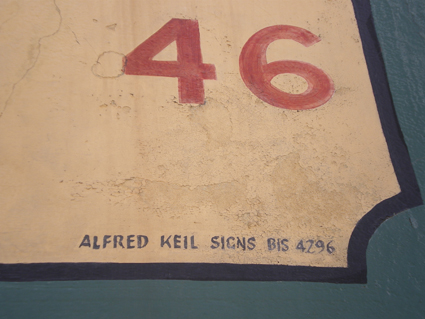
The above left image was achieved by surreptitiously pulling back one
of the window shutters. The signwriter has justifiably credited himself
in brush script on the top cartouche:
'ALFRED KEIL SIGNS BIS
4296'
'BIS' is the old London
exchange triplet of letters for Bishopsgate in the City of London.
All-numeral dialling codes were introduced around 1968.
[UPDATE March 2012: "A. Keil was my father
of
Alfred Keil Signs (based at 5 Whites Row) though his name was Angel
Keil - he did most of the sign writing in the East End and the City
during the the 1930's to the 1950's. I think he did the Percy Dalton
Sign too; he was quite friendly with him and I remember he did a sign
with a peanut for him. I wandered up there today and was really
pleased to see them still there. Regards, Connie Chesterman". Many
thanks to Connie for getting in touch; it must be a good feeling that
so-called epehemeral advertising signs are still in place long after
the companies have ceased. We think that the area would be a poorer
place without them. See also her note on the next sign...]
We noted in 2013 that this shop had been occupied by former 'Young
British Artist', Tracey Emin; the signs remained intact.
[UPDATE 25.2.2017: 'I
stumbled across your site today whilst looking for background for some
of my own photos of Spitalfields. I was particularly struck by the
notes regarding the Donovan Brothers signage at 46 Crispin street and
the additional comments from Connie Chesterman regarding her father -
the original sign-writer. Lovely stuff.
The explanation regarding the BIS telephone number rather implied that
the sign-writer must have done his work before 1968 after which the
telephone numbers became all numeric. However my own photo of this
shopfront, taken in 1985, shows the shop with it's previous red and
yellow design, so the green and yellow design painted by Connie's
father must be post 1985.
My own earliest photo showing the green frontage was taken in 1999 and
shows it signage looking rather 'tired' and ready for a repaint.
However the PERCY DALTON metal sign a couple of doors along, at that
point looks fairly good with just a few places where the paint is
beginning to peel.
By chance some of my early photos of Spitalfields were republished
today by the gentle author of Spitalfields Life, see:
http://spitalfieldslife.com/2017/02/24/philip-marriage-photographer/
and an earlier selection (one of which shows the Donovan Brs shopfront
in 1985) can be found at
http://spitalfieldslife.com/2012/06/15/philip-marriages-spitalfields/
Feel free to make use of this photo on your site if you think it will
help. Meanwhile, may I say - as an old typographer - how much I enjoyed
looking through your pages.
My best wishes, Phillip Marriage' We
are delighted to include the 1985 view of the Donovan Bros frontage and
admiring of Phillip's documenting of these streets over fifty years or
more.]
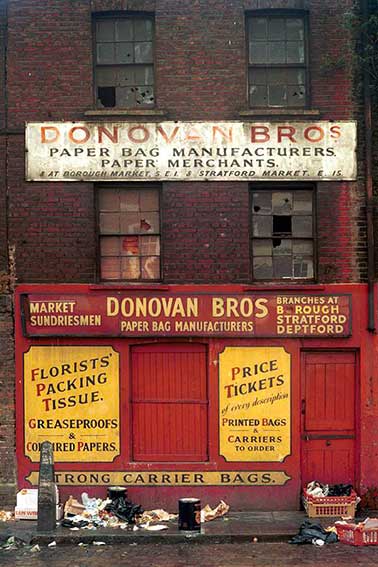 Crispin
St, 1985, courtesy Phillip Marriage
Crispin
St, 1985, courtesy Phillip Marriage
[UPDATE 31.10.2022: it wasn't
until we read the 2021 book Ghost
signs – a London story (Roberts, S & Roy Reed; see Reading list) that a fuller account of the
Donovan Brothers became clear. We have pleasure in quoting it here and
wholeheartedly recommend the book and website.
‘In about 1937 the five Donovan brothers, acting on their father’s
idea, opened a paper-bag shop on Slater Street to supply Spitalfields
Market. By 1940 they’d moved here [46 Crispin Street], later expanding
to many of London’s wholesale fruit markets, including Covent Garden,
Borough and Stratford. “Each of the brothers ran one, until they ran
out of family” wrote one of the current owners, Michael Donovan, in an
email to us [Roberts & Reed].
‘The shop on Crispin Street was run by Patrick Donovan, it shut in 1991
when the market and the Donovan Bros. moved to the New Spitalfields
Market in Leyton. The firm is now trading from Orpington in Kent, and
remains a family concern…
'… the brothers and their father might be turning in their graves at
the sight of the sign today. First painted in around 1946 by Alfred
Neil Signs, it has had two recent repaintings, with green replacing red
from the original colour scheme. To the family, red and yellow were
‘blood and gold’, perhaps symbolising family and business. Green was
never part of it. And Michael Donovan pointedly notes: “if my
grandfather had ever seen it painted green he would have had a fit!
Many Irishmen of his generation were very superstitious about the
colour green.” It’s unclear who commissioned the repainting, but this
particular creative decision was clearly badly informed.
'The sign is now well known beyond sign and history enthusiasts.
According to Michael Donovan, it has featured in photo-shoots, with
supermodel Naomi Campbell and music group Wet Wet Wet among those who
have posed in front of it. It was also immortalised in a painting by
artist Stuart Free, whose works focus on neglected aspects of everyday
history in London’s built environment.’ So much is wrapped up (pun intended) in
apparently inconsquential ephemera.]
Further details and images of the Donovan Bros. shop can be found on
the Ghost
signs website.
High above the present 'English Restaurant /
Oyster
Bar' on the corner
of Crispin Street and Brushfield Street, E1 we find a battered
advertisement.
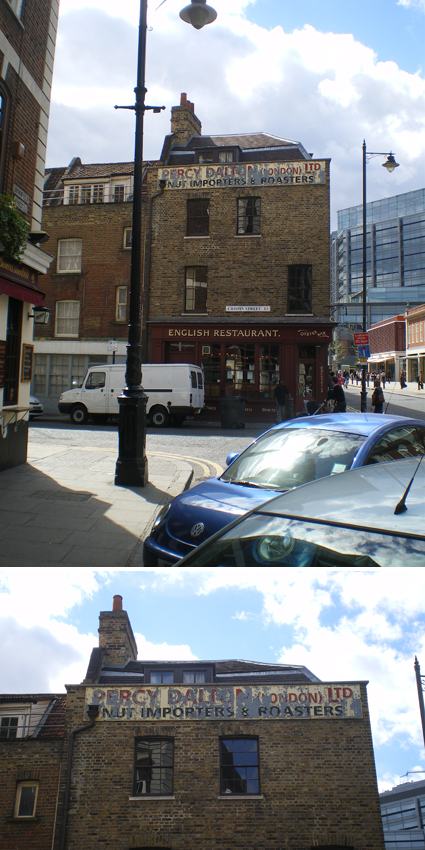
'PERCY
DALTON (LONDON) LTD.
NUT IMPORTERS & ROASTERS'
Simple red and black caps agaist a cream background, now all
hostage to the vagaries of the rain, wind and frosts. But what a great
sign...
[UPDATE 26.10.14: "Hi you might
remember I wrote to you about the Donovans facia that my father
painted. I have now spoken to my brother who lives in Canada and
he assures me that he and my father also painted the Percy Dalton sign
and that it is not painted on brickwork but on a metal sheet that is
fixed up with hooks; he remembers helping put it up. Kind regards,
Connie Chesterman"
4 Wilkes Street, E1
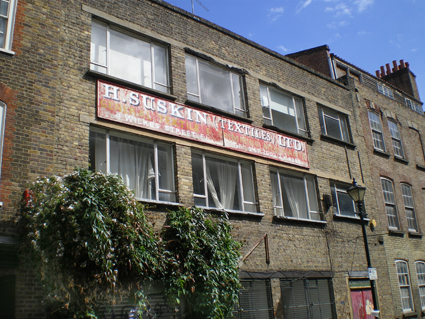
'H.
SUSKIN (TEXTILES) LTD.
GENERAL TEXTILE & TRIMMING MERCHANTS
4 WILKES STREET E1 TEL. 247
1602/3 4286'
The middle line of lettering is fugitive (orange-gold
against the red background). Someone has tried to overpaint the lower
part with white paint.
30
Fashion Street (John
Tibbatts & Sons)
Walking down Fashion Street, E1 from Brick Lane, we
spotted this
mysterious sign.
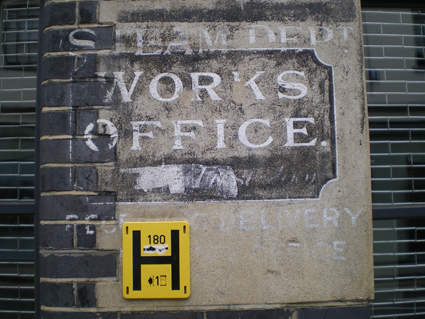
A double image (palimpsest) of white lettering across this
black-painted cartouche, outlined in white.
In the centre of the panel is:
'WORKS
OFFICE.'
and a pointing, cuffed hand (a manicule) indicates the
left
entrance. This pointer overlays italic lettering ('Est.' standing for
'Established and an indecipherable date?). Above this and running over
the white surround of the cartouche (so cannot originally have been
part of it?) are the somewhat mystifying words:
'STEAM
DEPT.'
Beneath and partially obscured by the yellow hydrant
sign are the faint words which we think are:
'RECEIVING DELIVERY
OFFICE'
[UPDATE 31.10.2022: the
2021 book Ghost signs – a London
story (Roberts, S & Roy Reed; see Reading
list) attributes this sign to the iron works of John Tibbatts & Sons which was here in the
1880s. The firm had other premises in the area from 1870 and by 1881
employed forty-five staff making items from bedsteads to fences.
[UPDATE
16.1.2021: This sign is on part of an extraordinary and long,
decorative building taking up much of the north side of the street
originally called The Moorish Market (information from: Caroline's
Miscellany, to whom our thanks). The Moorish Market was a Victorian
shopping centre, opened in 1905. It only ran as such for about four
years and this part was obviously later used as a factory.
Incidentally, on the street name: "The 1891 Census shows that most
inhabitants of the north side of the street worked in tailoring and
associated trades. That offers a tempting explanation for the street
name, but in fact 'Fashion' is a corruption of the original 'Fossan
Street'."]
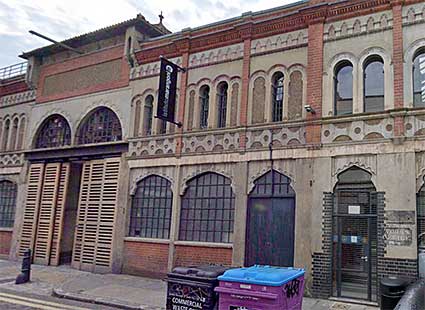 2020 images
2020 images
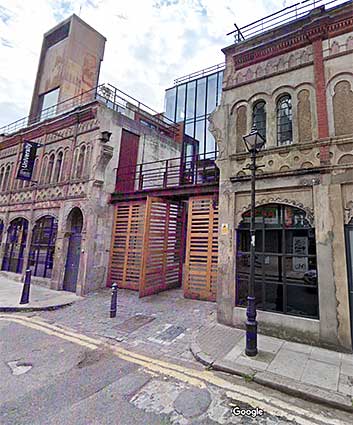
The street scene above left shows the sign in situ at lower right. Further
down
the street is another destroyed entrance to the market (above right)
where the decorative arches have gone, leaving stubs on each side. The
stone setts making up the entry are clearly visible and, underneath a
layer of decaying tarmac, on the street, too. This building is partly
occupied by The London/British School of Fashion, which would be
appropriate to the name of the street if that hadn't derived from
something which wasn't at all fashionable (see above).
'Commit no Nuisance'
Incidentally, the Spitalfields
Life blog (January 2021) shows a fading admonition painted
discreetly in Fournier Street on the side of Hawksmoor's Christ
Church, Spitalfields. The 'gentle author' says: "In fact, I am reliably
informed that this sign is actually employing the language of euphemism
to instruct customers of the Ten Bells not [to] urinate against the
church wall. Almost faded into illegibility today, with pitiful
nobility, 'Commit no Nuisance', speaks in a polite trembling whisper
that is universally ignored by those passing in Commercial St."
We have found similar signs in Tewkesbury
and St Albans.
For further examples see our London Galleries page including some from nearby Shoreditch.
 2020 images
2020 images

 2020 images
2020 images


















